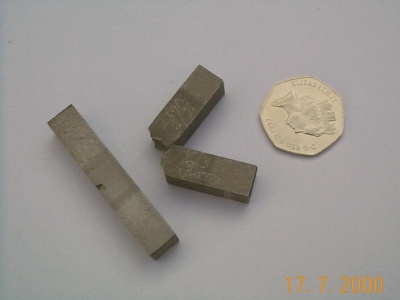On Tue, 9 Jun 2020 at 8:31, LALIT VADADORIYA<lalit.vadadoriya@gmail.com> wrote:Dear sir,
Normalizing is the process where an as-rolled plate is heated back up to approximately 900°C, and held at that temperature for a specific time, before being allowed to cool naturally. This process refines the grain size and improves the mechanical properties, specifically the toughness. It renders the properties more uniform, and removes residual rolling strains.
The toughness of the steel, and its ability to resist this behaviour, decreases as the temperature decreases. In addition, the toughness required, at any given temperature, increases with the thickness of the material.
A convenient measure of toughness is the Charpy V-notch impact test (hence the term "notch toughness" has been widely used in the past). This test measures the impact energy (in Joules) required to break a small, notched specimen by a single impact blow from a pendulum. The tests are carried out with the specimens at specified (low) temperatures, and the CEN product standards specify the required minimum impact energy values for different grades.
Regards
Lalit VadadoriyaMob.9377072930--On Mon, Jun 8, 2020 at 12:50 PM Mahmood Al-Hinai <hyna4444@gmail.com> wrote:Dear all,--Why normalizing process increases the toughness property of flange?Thanks,Mahmood+968 97133004
https://materials-welding.blogspot.com/
https://www.linkedin.com/groups/122787
---
You received this message because you are subscribed to the Google Groups "Materials & Welding" group.
To unsubscribe from this group and stop receiving emails from it, send an email to materials-welding+unsubscribe@googlegroups.com.
To view this discussion on the web visit https://groups.google.com/d/msgid/materials-welding/CAEuX%2BdmBnokAdWfC5xMk3L8e2qUGsbqMa1ExALzMvTTnzSxj6Q%40mail.gmail.com.
https://materials-welding.blogspot.com/
https://www.linkedin.com/groups/122787
---
You received this message because you are subscribed to the Google Groups "Materials & Welding" group.
To unsubscribe from this group and stop receiving emails from it, send an email to materials-welding+unsubscribe@googlegroups.com.
To view this discussion on the web visit https://groups.google.com/d/msgid/materials-welding/CAKjb_1KzwOUz2DnJAn%3D9g0jAg_S%2B4MwkK3-fpawq6%2BWWfMQO6Q%40mail.gmail.com.
https://materials-welding.blogspot.com/
https://www.linkedin.com/groups/122787
---
You received this message because you are subscribed to the Google Groups "Materials & Welding" group.
To unsubscribe from this group and stop receiving emails from it, send an email to materials-welding+unsubscribe@googlegroups.com.
To view this discussion on the web visit https://groups.google.com/d/msgid/materials-welding/1918143298.382948.1591702018728%40mail.yahoo.com.

No comments:
Post a Comment